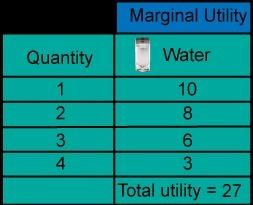
Business, 31.05.2020 03:05 andrew5182
Piper Corp. is operating at 70% of capacity and is currently purchasing a part used in its manufacturing operations for $24 per unit. The unit cost for the business to make the part is $36, including fixed costs, and $26, not including fixed costs. If 15,000 units of the part are normally purchased during the year but could be manufactured using unused capacity, what would be the amount of differential cost increase or decrease from making the part rather than purchasing it? a. $180,000 cost increase b. $30,000 cost increase c. $30,000 cost decrease d. $180,000 cost decrease

Answers: 2


Other questions on the subject: Business

Business, 22.06.2019 21:50, elijahjacksonrp6z2o7
The third program provides families with $50 in food stamps each week, redeemable for both perishable and nonperishable food. the fourth policy instead provides a family with a box of nonperishable foods each week, worth $50. use two graphs to illustrate that a family may be indifferent between the two programs, but will never prefer the $50 box of nonperishable foods over the $50 in food stamps. state your answer and use a consumer choice model for perishable food and nonperishable food to graphically justify your choice.
Answers: 1

Business, 22.06.2019 22:10, zahraa244
Afirm plans to begin production of a new small appliance. the manager must decide whether to purchase the motors for the appliance from a vendor at $10 each or to produce them in-house. either of two processes could be used for in-house production; process a would have an annual fixed cost of $200,000 and a variable cost of $7 per unit, and process b would have an annual fixed cost of $175,000 and a variable cost of $8 per unit. determine the range of annual volume for which each of the alternatives would be best. (round your first answer to the nearest whole number. include the indifference value itself in this answer.)
Answers: 2

Business, 22.06.2019 22:40, gracebuffum
In a fixed-term, level-payment reverse mortgage, sometimes called a reverse annuity mortgage, or ram, a lender agrees to pay the homeowner a monthly payment, or annuity, and expects to be repaid from the homeowner’s equity when he or she sells the home or obtains other financing to pay off the ram. consider a household that owns a $150,000 home free and clear of mortgage debt. the ram lender agrees to a $100,000 ram for 10 years at 6 percent. assume payments are made annually, at the beginning of each year to the homeowner. calculate the annual payment on the ram.
Answers: 1

Business, 22.06.2019 23:30, Wolfgirl2032
Mystic bottling company bottles popular beverages in the bottling department. the beverages are produced by blending concentrate with water and sugar. the concentrate is purchased from a concentrate producer. the concentrate producer sets higher prices for the more popular concentrate flavors. a simplified bottling department cost of production report separating the cost of bottling the four flavors follows:
Answers: 3
You know the right answer?
Piper Corp. is operating at 70% of capacity and is currently purchasing a part used in its manufactu...
Questions in other subjects:


Arts, 17.09.2019 17:00

Biology, 17.09.2019 17:00

History, 17.09.2019 17:00


World Languages, 17.09.2019 17:00








